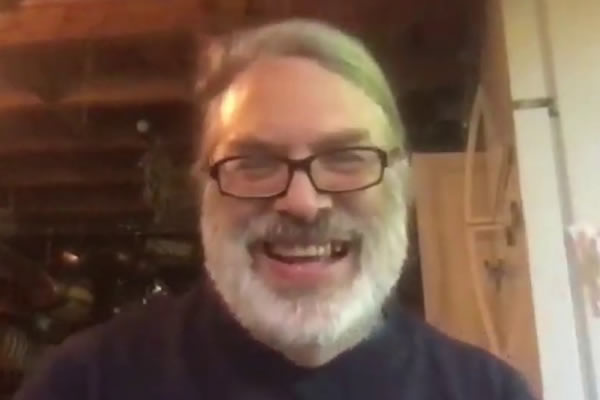Matthew Wood – Herbalist
Q. Who are you and what do you do?
Since my teens, I was interested in being a herbalist. It was my calling, and I really couldn’t do anything else. By age 18 I was attending university studying botany, but naturopathy didn’t exist. I hadn’t heard of it until I’d been practising for 5 or 6 years, and by that point I didn’t know if I wanted to reach more people. I’ve always kept a small clientele to teach and write. I’m so driven to teach and write, those two, together, are my path.
I started practising at The Herbs Store in 1981 with Bob Gallagher, the owner of the store. One thing he taught me which was really beautiful in the first year. He said –‘The beautiful thing about herbalism, is you can never know it all. There is always another leaf to turn over’. And that is so true! You can never know every single herb or every single application! And that’s been a wonderful little lesson that I learnt early on.
8 years later I went out and started practising at a Chiropractic clinic, and then I practised on my own for 20 years or so.
Q. Your approach is very different to what we see in modern times (i.e.: scientific herbalism – using herbs as active chemicals). How is your approach different, and why do you prefer that?
I practice herbal medicine using small doses, which is not unknown in the whole history of herbal medicine. I also look for the “essence”; how to understand the entire pattern, the wholeness of the herb and the process in the person. In fact, that is what I think is missing in modern herbal medicine and naturopathy sometimes, because it’s looking at chemistry and reductionism down to the particle, rather than the whole process. It’s not like the old days, where, for example, you had ‘liver problems’ because of malaria, but nowadays we have ‘gastric problems’ because of the toxins in foods. So you could say, stomach problems/ GI problems, and in modern medicine you’d have a ‘gastroenterologist’ dealing with the specific complaint. As a herbalist, you have to train yourself to see the entire pattern – which is a more intuitive approach. Herbs come straight out of nature to deal with these processes – ie: they deal with too hot, too cold, too light, etc., they accommodate and address those conditions.
So that’s what we should be doing, building on the folk history and, from that, build on scientific understanding. I have naturally thought this way, although my upbringing was a little different. When I was an infant, we moved to a very isolated Native American reservation in southern Florida and they didn’t speak English as their first language. Although I didn’t learn to talk until after we left, I could understand the people and got a different set of insights and references than from western culture. That’s why I think it is so easy for me to eschew western science and go off in the old intuitive fashion. Later, I got my Master’s degree from the University of Wales, and that helped me understand and appreciate science in those days – being able to read papers and work from folk medicine to (scientific) papers.
Q. In your work, you talk a lot about tissue state and that is something that is rarely mentioned now. Why should herbalists stay connected to that?
Well, it’s about energetics, and it’s the more modern terminology on energetics. If you go to a neurology textbook you will see all those ‘tissue states’. You will have incitation or irritation; that’s overstimulation. Then we have depression, meaning under-stimulation, not mental depression. Then we have relaxation: these are actual medical terms. If you were examining people, you would write their physiology or neurological terms. Then there’s constriction, but I’d say tension, nervous atrophy and torpor (this doesn’t always appear in textbooks). That’s really stagnation, it’s a little different from relaxation. So, we have 6 tissue states, and they correspond fairly well to old Greek medicine, being: hot, cold, damp, dry.
Traditionally, energetics was accepted by everyone; Greek, Ayurvedic, Chinese, some Native Americans, and also in African medicine too. It’s about drawing on these traditions from different cultures that we find to be very universal. I would also say that there is spiritualism. Spirts causing the diseases. Then we have humoralism which is an energetic system, and then we have modern medicine, too – so it’s all part of a process.
Q. You are coming to speak at the ANP Summit. What will you be covering?
I want to cover some introductory ideas (energetics), but the main thing I will be covering is remedies for tissue states, and the great heritage gift of female reproductive remedies, known from the Native American people. There are about a dozen great female remedies from native America but I will be talking about other things like Rhemmina root and so on because there are some great (other) herbs I want to discuss, as well.
Q. What is your favourite Herb
Yarrow. It’s impossible not to love Yarrow. It’s a women’s remedy for heavy bleeding. It’s for cuts, wounds, fevers and colds. It has very strong control over the neurovascular system, so BOOM it can stop the bleeding in one area , and can spread the capillary blood out elsewhere in the body. It also has more complex internal uses, from GI irritation and lack of tone. It’s also good for fibroids. It’s one of the better fibroid remedies.
By Tegan Philp




